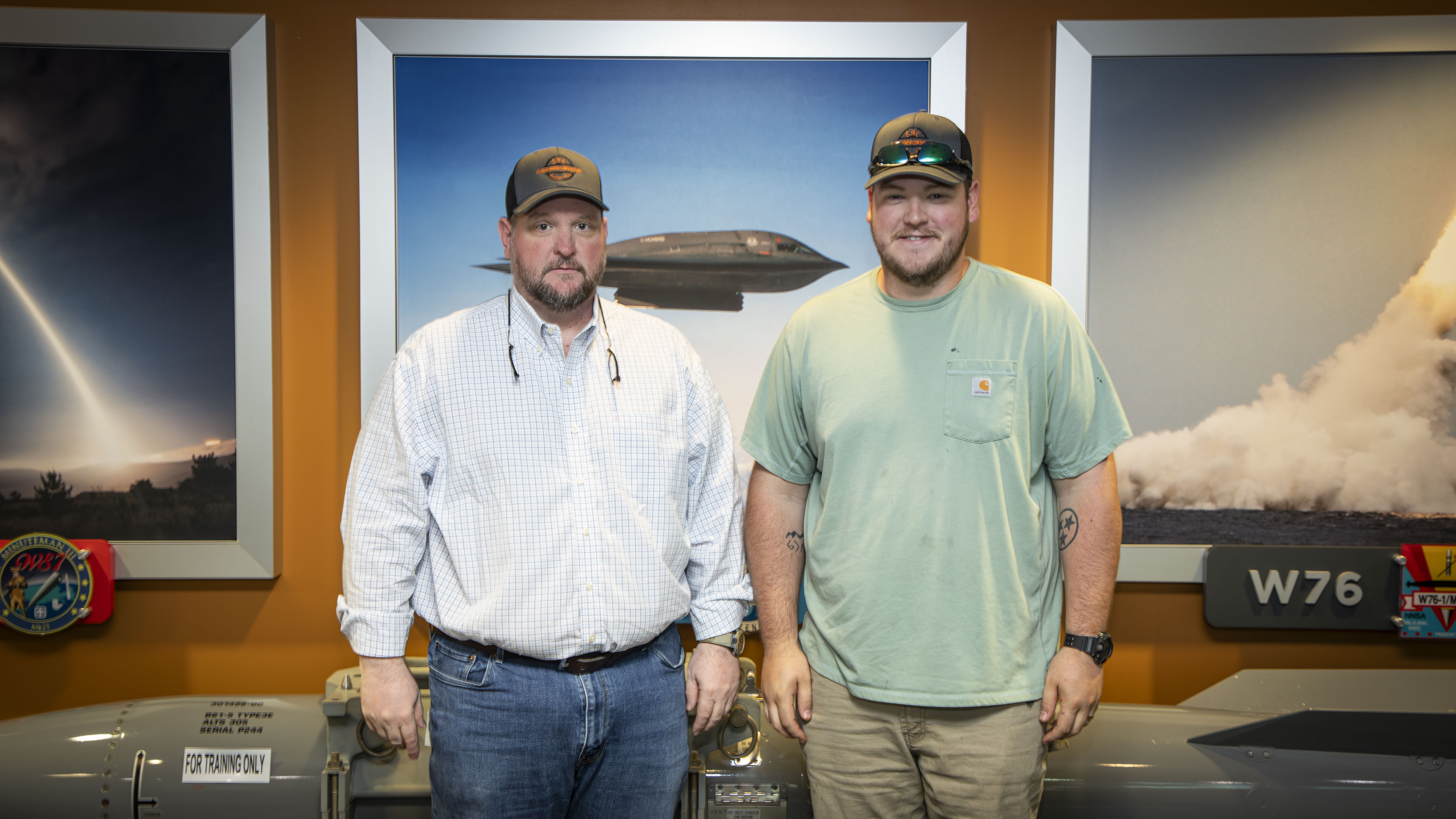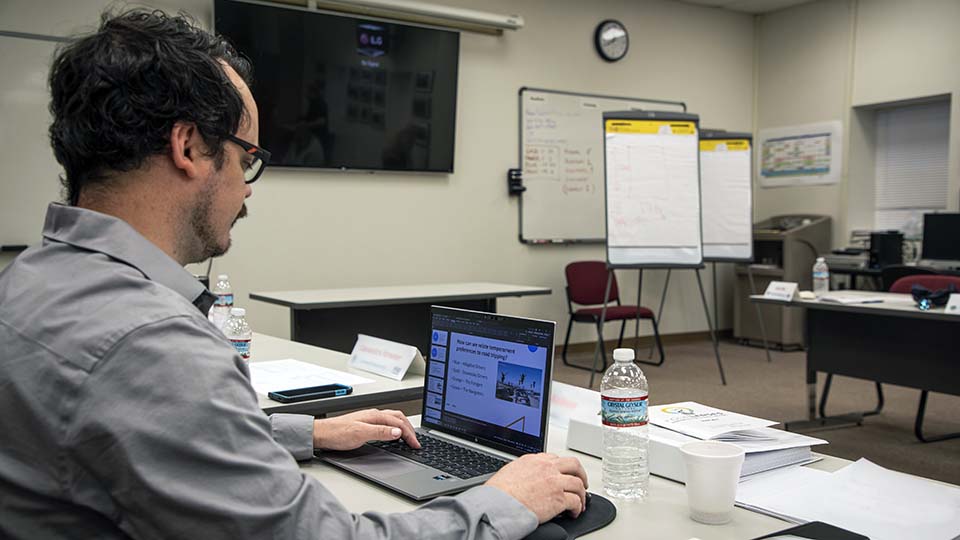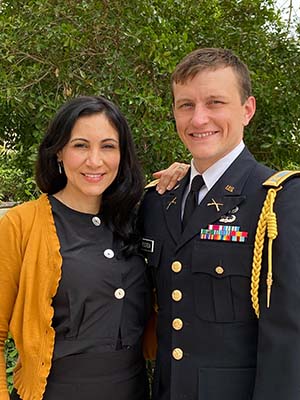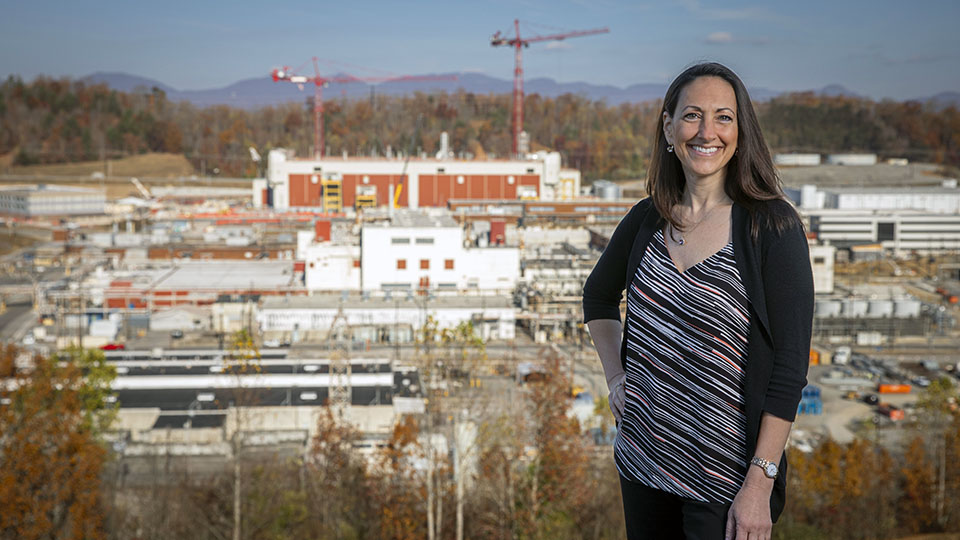Y-12 Blog

Y-12er father and son, Tim and Zach, love that they have a shared mission at work.
June is the month to celebrate the fathers in our lives. Some lucky employees have the privilege of working with their fathers on‑site.
Meet Y-12ers Tim and Zach H., father and son.
Tim, a project manager in Y-12 Projects, and Zach, an electrician in Y-12 Construction, know very well what it looks like to follow in their fathers’ footsteps. Tim’s father and grandfather both worked at Y-12, and just like Zach, Tim started his career at Y-12 as an electrician.
“It is really cool to be able to say you are part of four generations who have worked to serve the very important mission here at Y-12 and have helped secure our nation’s freedom,” Tim said.
While they don’t get to see each other at work often, Tim says he’s fortunate to have a front row seat to see Zach grow in his career, be able to provide him with advice, and share the perspective he’s gained throughout his time at Y-12.
“He has taught me the importance of providing for my family and that if you have a good work ethic, the reward will find you,” Zach said about his dad.
From professional to personal achievements, Tim shares that he is proud of seeing Zach grow into the man he has become.
“Zach makes me proud on so many levels,” Tim said. “He is a new father himself and is such a great dad. On a professional level, he is someone who can be counted on to deliver and is always willing to learn new things. I guess that is something that Y-12 and I have in common; we are both lucky to have Zach.”

Wireless technology has made its way to the Central Training Facility (CTF), creating a more efficient learning environment for security police officers.
Located about 8 miles west of Y‑12, CTF is a DOE‑certified and approved weapons qualification and training facility used to equip security personnel to protect national security assets, facilities, people, and government property.
“The CTF holds a variety of courses that range from entry‑level to tactical training disciplines,” said Jay W., CTF Range Operations manager.
Class sizes vary from 10 to 35 students, and courses are open to all DOE sites. The facility also holds site‑specific training and qualifications for more than 650 security police officers across three entities: Oak Ridge National Laboratory, Oak Ridge Protective Force, and Y‑12.
Trainees previously were unable to connect to the CNS network due to the lack of wired terminals. The installation of unclassified wireless access points now allows the classroom portion of the training to transition to online learning.
“Having wireless connectivity is a significant productivity gain for our facility where students previously had to share a single computer to access National Training Center coursework through a wired connection point,” Jay said. “Now, students are able to connect at any point using their laptops and cell phones.”
Collaboration among CTF, Information Solutions and Services, Safeguards and Security, and Operations Health brought project success earlier than expected.
“A WiFi signal at CTF was something we didn’t believe was possible a year ago,” said Joe R., Physical Security senior engineer. “Yet, we finished the entire process — from configuration and testing to installation — in 12 months.”
Now that the facility has the foundation to connect wirelessly, additional resources are being planned to further develop the facility and classroom training. For instance, a wireless‑enabled air‑quality monitoring system for the indoor range is being tested to fulfill an Occupational Safety and Health Administration requirement. Once operational, the system will allow range managers to observe and maintain environmental and occupational controls to protect personnel from the effects of lead, noise, or any other relevant exposures.
Training costs will also be significantly reduced over time as pages of lesson plans are moved to a web‑based platform. “Students without computers still have the option to have physical copies of the training manuals, but we’re looking forward to being able to go fully electronic,” Jay said.
To support a full‑time online training environment, the facility’s goal is to establish a wireless computer lab by Fiscal Year 2025 after evaluations and testing are complete. As of March, the CTF conducted a test bed with a basic instructor class of 16 personnel.
“Once finished, the computer lab will give us the option to completely eliminate the need to print training materials,” Jay said. “Based on current manuals at 750 pages for each student, we estimate that we’ll save approximately 26,250 pages per training class, plus have the availability to apply updates automatically without reprinting.”
Installing unclassified wireless at the CTF is a sign of progress, and Digital Transformation integrated product teams are continuing to make risk-informed decisions to enable wireless in other areas across the site while complying with technical security, cybersecurity, and NNSA requirements.
“Our end goal is to implement solutions that support access to business, security, and operations systems site‑wide through wireless technology,” said Mark P., Digital Transformation senior manager. “Right now, we are still in the process of determining requirements and maturing technical implementation plans to address any potential wireless vulnerabilities and ensure that we’re delivering the best product for our mission.”

.Celebrating Armed Forces Day
Being part of a military family has challenges and benefits unique to military service. Our servicemembers give up a lot of freedoms to protect our nation, but so do the families supporting them. These families are often unrecognized for their role in service to the nation. They often don’t have a choice regarding where they will live and work. The servicemember is deployed for months at a time, leaving the family behind to deal with the home front.
That longing for togetherness as well as concerns for safety are heightened when the servicemember is deployed to a combat environment.
“The most challenging part of being a military family is when the servicemember gets deployed to a remote location and communicating is very limited,” said Lisa H., information specialist in CNS Communications at Y‑12. “This is especially challenging when the remote location is in a war zone. When your family member is away, you try to keep busy with day‑to‑day challenges of life, but your mind is always on the one deployed.”
Those extended deployments can stress the family environment, but they also create opportunities.

Y‑12er Rose R. stands with her husband, Major Brennan R., at his promotion ceremony.
Rose R., Y‑12 administrative assistant for Nuclear Safety, describes her life as an adventure.
“Being a military family is different to lives as nonmilitary families, as expectations for your level of flexibility and resiliency are much higher than in regular civilian life,” Rose said. “We have moved 7 times in the past 14 years to places like Vicenza, Italy; Tunis, Tunisia; and my husband is currently stationed in Mali. It can be difficult to plant deep roots anywhere, but you have roots far and wide, across the U.S. or the world, wherever your posts may be.”
Like their active‑duty counterparts, many military families develop deep bonds with other families where they’re stationed.
“Your military friends and associates become your family members, especially when serving overseas,” Lisa said. “You are in a small, remote group with the same purpose. They are family you will always maintain contact with, just as you would your immediate family. If you need help, your ‘family’ will be the ones there to assist.”
The bond that military family members who work at Pantex and Y‑12 share also strengthens their sense of pride to be part of the sites’ missions, knowing the work they do directly affects their servicemembers’ lives.
As both seen and unseen sacrifices continue to be made daily for the protection of our nation, Pantexans and Y‑12ers would like to say “thank you” to all active servicemembers, veterans, and military families for all they give in service to this country.
May is the month to celebrate the mothers in our lives. Some lucky employees even have the privilege of working with their mothers on-site.

Meet Y-12er mother and son, Patty and Bryson B.
Bryson B., roads and grounds laborer for Y-12 Infrastructure, joined Y-12 in 2021 and thought it was especially neat to see the place his mom and dad worked for many years.
“The best part of working in the same company is being able to spend time with each other more often and occasionally spend time together at work as well,” Bryson said.
Patty B., scheduler in Y-12 Project Controls, who started at Y-12 in 2011, says while their fields of work aren’t related, as a mom, she loves that they have a shared mission at work.
“It’s awesome knowing we both have the opportunity to help our site and our nation in some small way,” she said.
Bryson is grateful for the example his mom has set for him throughout his life.
“My mom has always shown me hard work, respect, and honesty with everything she does, and I try my best to replicate and follow these great examples,” he said.
To say that Patty is proud of her son would be an understatement.
“Bryson has accomplished many things in his life,” she said. “I am thankful and proud of each one, but I am most proud of who he is. He is such a wonderful person. He is a sweet soul, always keeps you laughing, and makes life fun. He is a complete joy to be with, and of course to me, the best son in the world.”

Take 5 minutes to learn about Julie Huff, UPF Commissioning director. All views and opinions are the employee’s own and do not necessarily reflect those of CNS.
Employees of Y‑12 may often feel like they’ve taken a ride in the DeLorean time machine as they travel through the site. Older facilities provide a glimpse into the 1940s and the historic deliveries during the Manhattan Project, while construction of projects such as the Uranium Processing Facility (UPF) and the Lithium Processing Facility (LPF) thrust the landscape into the future.
Julie Huff, UPF Commissioning director, has had the opportunity to work in a number of production facilities across the site throughout her career at Y‑12. Her experiences in older facilities have proven to be an asset in her current role.
“I’ve worked at Y‑12 for almost 23 years now, and I started my role in UPF Commissioning in June 2022. My primary role is to lead the charge to ensure UPF meets all the requirements to operate as a nuclear facility: preparing the people, the paper, and the processes to successfully pass the Operational Readiness Reviews. Preparing the facility to operate also means planning for transition logistics and preparing current Y‑12 operations and personnel for when UPF is construction complete,” Huff said. “I’ve had the good fortune of being able to see and experience the current facilities and work with a wide number of Y‑12 organizations in my years here, and that has helped me tremendously when thinking through the impacts on our Y‑12 employees now and in the future.”
During her tenure at Y‑12, no matter the facility or organization that she has been a part of, Huff has continued to be impressed and inspired by the dedication and perseverance of fellow Y‑12ers and those at Pantex.
“I believe the environment you’ll find at Y‑12 or Pantex, the level of dedication of the people, cannot be beat compared to other places of work,” Huff said. “You feel and appreciate that every job serves an important purpose to our sites as a whole and makes a difference in delivering the mission. This continues to energize me and motivate me every day.”
How has working for CNS changed or reinforced your thoughts on our mission?
I am a nuclear engineer, and I have always been passionate about the capabilities of nuclear energy, but I don’t think I fully grasped the magnitude until I came to work at Y‑12. My grandfather and his brothers served in WW2, and it was when I began working here and seeing the work that we do and the history of the Manhattan Project that really made me fully appreciate what Y‑12 has done for this country. The work done here to help end WW2 did not just impact the world in the 1940s, but continues to this day. The world and war forever changed with our capabilities and with deterrence.
What work advice would you offer someone who is new to Pantex or Y‑12?
My top piece of advice would be that before looking outside the company to grow in your career, explore opportunities within your site in a different organization. I like to say that Y‑12 is its own little city that requires different roles, skills, and knowledge. You can have an amazing career here and work your way up this way.
What’s your top bucket list item and why?
My top bucket list item is to visit Antarctica, and maybe even run in the Antarctica Marathon that is held every year. Yes, there is a marathon in Antarctica. My goal is to visit all seven continents, and Antarctica is the hardest one on my list. It just looks so beautiful, and I hope to see it someday.
Who in your life has inspired you the most and why?
My daughter. She always amazes me and challenges me to be a better person. I love seeing the world through her eyes, and I want to make the world a better place for her now and into the future.
